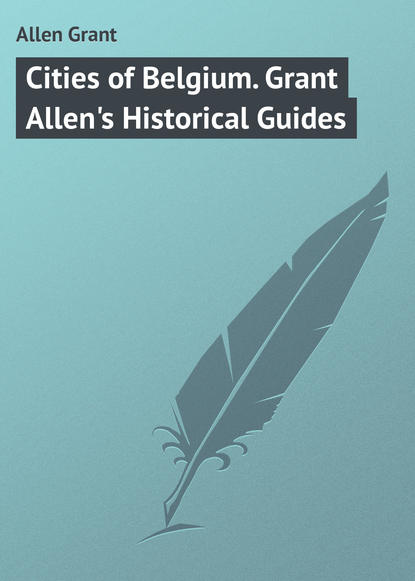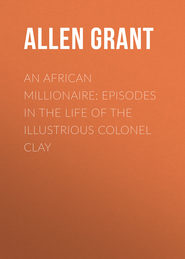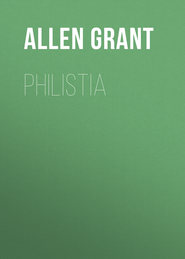По всем вопросам обращайтесь на: info@litportal.ru
(©) 2003-2024.
✖
Cities of Belgium. Grant Allen's Historical Guides
Настройки чтения
Размер шрифта
Высота строк
Поля
*2nd panel: the Maidens and the Pope arrive at Cologne, where they are instantly set upon by the armed Huns. Conon is slain by the thrust of a sword, and falls back dying in the arms of St. Ursula. Many of the maidens are also slaughtered.
*3rd panel: continuous with the last, but representing a subsequent moment: the Martyrdom of St. Ursula. The King of the Huns, in full armour, at the door of his tent, bends his bow to shoot the blessed martyr, who has refused his advances. Around are grouped his knights in admirably painted armour. (Note the reflections.) All the scenes have the character of a mediæval romance. For their open-air tone and make-believe martyrdom, see Conway.
At the ends of the shrine are two other pictures, (1) *St. Ursula with her arrow, as the protectress of young girls, sheltering a number of them under her cloak (not, as is commonly said, the 11,000 Virgins). Similar protecting figures of the saint are common elsewhere (Cluny, Bologna, etc.). At the opposite end, (2) the Madonna and Child with an apple, and at her feet two Augustinian nuns of this Hospital, kneeling, to represent the devotion of the order.
The roof of the shrine is also decorated with pictures. (1) St. Ursula receiving the crown of martyrdom from God the Father, with the Son and the Holy Ghost; at the sides, two angels playing the mandoline and the regal or portable organ; (2) St. Ursula in Paradise, bearing her arrow, and surrounded by her maidens, who shared her martyrdom, together with the Pope and other ecclesiastics in the background. (This picture is largely borrowed from the famous one by Stephan Lochner on the High Altar of Cologne Cathedral, known as the Dombild. If you are going on to Cologne, buy a photograph of this now, to compare with Meister Stephan later. His altar-piece is engraved in Conway. If you have it with you, compare them.) At the sides are two angels playing the zither and the violin. (The angels are possibly by a pupil.)
I have given a brief description only of these pictures, but every one of them ought to be carefully examined, and the character of the figures and of the landscape or architectural background noted. You will see nothing lovelier in all Flanders.
Near the window by the entrance is a **Triptych, also by Memling, commissioned by Brother Jan Floreins of this Hospital. The central panel represents the Adoration of the Magi, which takes place, as usual, under a ruined temple fitted up as a manger. The Eldest of the Three Kings (according to precedent) is kneeling and has presented his gift; Joseph, recognisable (in all three panels) by his red-and-black robe, stands erect behind him, with the presented gift in his hands. The Middle-aged King, arrayed in cloth of gold, with a white tippet, kneels with his gift to the L. of the picture. The Young King, a black man, as always, is entering with his gift to the right. The three thus typify the Three Ages of Man, and also the three known continents, Europe, Asia, Africa. On the L. side of this central panel are figured the donor, Jan Floreins, and his brother Jacob. (Members of the same family are grouped in the well-known “Duchâtel Madonna,” also by Memling, in the Louvre.) To the right is a figure looking in at a window and wearing the yellow cap still used by convalescents of the Hospital, (arbitrarily said to be a portrait of Memling.) The left panel represents the Nativity, with our Lady, St. Joseph, and two adoring angels. The right panel shows the Presentation in the Temple, with Simeon and Anna, and St. Joseph (in red and black) in the background. (The whole thus typifies the Epiphany of Christ; left, to the Blessed Virgin; centre, to the Gentiles; right, to the Jews.) The outer panels, in pursuance of the same idea, have figures, right, of St. John Baptist with the lamb (he pointed out Christ to the Jews), with the Baptism of Christ in the background; and left, St. Veronica, who preserved for us the features of our Lord, displaying his divine face on her napkin. The architectural frame shows the First Sin and the Expulsion from Paradise. Note everywhere the strong character in the men’s faces, and the exquisite landscape or architectural backgrounds. Dated 1479. This is Memling’s finest altar-piece: its glow of colour is glorious.
By the centre window, a *triptych, doubtfully attributed to Memling, represents, in the centre, the Deposition from the Cross, with the Holy Blood conspicuous, as might be expected in a Bruges work. In the foreground are St. John, the Madonna, and St. Mary Magdalene; in the background, the preparations for the Deposition in the Tomb. On the wings: left, Brother Adrian Reins, the donor, with his patron saint, Adrian, bearing his symbol, the anvil, on which his limbs were struck off, and with his lion at his feet; right, St. Barbara with her tower, perhaps as patroness of armourers. On the exterior wings, left, St. Wilgefortis with her tau-shaped cross; right, St. Mary of Egypt, with the three loaves which sustained her in the desert.
On the same stand is the beautiful *diptych by Memling, representing Martin van Nieuwenhoven adoring the Madonna. The left panel represents Our Lady and the Child, with an apple, poised on a beautifully painted cushion. A convex mirror in the background reflects the backs of the figures (as in the Van Eyck of the National Gallery). Through the open window is seen a charming distant prospect. The right panel has the fine portrait of the donor, in a velvet dress painted with extreme realism. Note the admirable prayer-book and joined hands. At his back, a stained glass window shows his patron, St. Martin, dividing his cloak for the beggar. Below, a lovely glimpse of landscape. This is probably Memling’s most successful portrait. Dated 1487: brought here from the Hospice of St. Julian, of which Martin was Master.
In all Flemish art, observe now the wooden face of the Madonna– ultimately derived, I believe, from imitation of painted wooden figures, and then hardened into a type. As a rule, the Madonna is the least interesting part of all Flemish painting; and after her, the women, especially the young ones. The men’s faces are best, and better when old: character, not beauty, is what the painter cares for. This is most noticeable in Van Eyck, but is true in part even of Memling.
At the end of the room is the magnificent *triptych painted by Memling for the High Altar of the Church of this Hospital. This is the largest of his works, and it is dedicated to the honour of the two saints (John the Evangelist and John the Baptist) who are patrons of the Hospital. The central panel represents Our Lady, seated in an exquisite cloister, on a throne backed with cloth of gold. To the right and left are two exquisite angels, one of whom plays a regal, while the other, in a delicious pale blue robe, holds a book for Our Lady. Two smaller angels, poised in air, support her crown. To the left, St. Catherine of Alexandria kneels as princess, with the broken wheel and the sword of her martyrdom at her feet. The Child Christ places a ring on her finger; whence the whole composition is often absurdly called “The Marriage of St. Catherine.” It should be styled “The Altar-piece of the St. Johns.” To the right is St. Barbara, calmly reading, with her tower behind her. When these two saints are thus combined, they represent the meditative and the active life (as St. Barbara was the patroness of arms:) or, more definitely, the clergy and the knighthood. Hence their appropriateness to an institution, half monastic, half secular. In the background stand the two patron saints; St. John Baptist with the lamb (Memling’s personal patron), to the left, and St. John the Evangelist with the cup and serpent, to the right. (For these symbols, see Mrs. Jameson.) Behind the Baptist are scenes from his life and preaching. He is led to prison, and his body is burned by order of Julian the Apostate. Behind the Evangelist, he is seen in the cauldron of boiling oil. The small figure in black to the right is the chief donor, Brother Jan Floreins, who is seen further back in his secular capacity as public gauger of wine, near a great crane, which affords a fine picture of mercantile life in old Bruges. The left wing represents the life of St. John the Baptist. In the distance is seen the Baptism of Christ. In a room to the left, the daughter of Herodias dances before Herod. The foreground is occupied by the episode of the Decollation, treated in a courtly manner, very redolent of the Burgundian splendour. Figures and attitudes are charming: only, the martyrdom sinks into insignificance beside the princess’s collar. Other minor episodes may be discovered by inspection. (The episodes on either wing overflow into the main pictures.) The right wing shows St. John the Evangelist in Patmos, writing the Apocalypse, various scenes from which are realistically and too solidly represented above him, without poetical insight. Memling here attempts to transcend his powers. He has no sublimity. On the exterior of the wings are seen the four other members of the society who were donors of the altar-piece; Anthony Zeghers, master of the Hospital, with his patron, St. Anthony, known by his pig and tau-shaped crutch and bell: Jacob de Cueninc, treasurer, accompanied by his patron, St. James the Greater, with his pilgrim’s staff and scallop-shell: Agnes Casembrood, mistress of the Hospital, with her patron, St. Agnes, known by her lamb: and Claire van Hulsen, a sister, with her patron, St. Clara. Dated, 1479.
By the entrance door is a Portrait of Marie Moreel, represented as a Sibyl. She was a daughter of Willem Moreel or Morelli, a patron of Memling, whom we shall meet again at the Museum. This is a fine portrait of a solid, plain body, a good deal spoiled by attempted cleaning. It comes from the Hospice of St. Julian.
As you go out, cast a glance at the fine old brick buildings, and note the cleanliness of all the arrangements.
Return more than once: do not be satisfied with a single visit.
The other pictures and objects formerly exhibited in this Hospital have been transferred to the Potterie and another building. They need only be visited by those whose time is ample.
After leaving the Hospital, I do not advise an immediate visit to the Academy. Let the Memlings first sink into your mind. But the walk may be prolonged by crossing the canal, and taking the second turning to the R., which leads (over a pretty bridge of three arches) to the Béguinage, a lay-nunnery for ladies who take no vows, but who live in monastic fashion under the charge of a Superior. Above the gateway is a figure of St. Elizabeth of Hungary, (to whom the church within is dedicated) giving alms to a beggar. She wears her crown, and carries in her hand the crown and book which are her symbol. Remember these, – they will recur later. Pass under the gateway and into the grass-grown precincts for an external glimpse of the quiet old-world close, with its calm white-washed houses. The church, dedicated to St. Elizabeth, is uninteresting. This walk may be further prolonged by the pretty bank of the Lac d’amour or Minnewater as far as the external canal, returning by the ramparts and the picturesque Porte de Gand.
D. THE TOWN IN GENERAL
[The town of Bruges itself is more interesting, after all, than almost any one thing in it. Vary your day by giving up the morning to definite sight-seeing, and devoting the afternoon to strolls through the town and neighbourhood, in search of picturesqueness. I subjoin a few stray hints for such casual rambles.]
(1) Set out from the Grand’ Place, and turn down the Rue Breydel to the Place du Bourg. Cross the Place by the statue of Jan van Eyck; traverse the Rue Philippe Stock; turn up the Rue des Armuriers a little to the R., and continue on to the Place St. Jean, with a few interesting houses. Note here and elsewhere, at every turn, the little statues of the Virgin and Child in niches, and the old signs on the fronts or gables. The interesting Gothic turret which faces you as you go belongs to the old 14th Century building called De Poorters Loodge, or the Assembly Hall of the Noble Citizens Within the Gate, as opposed to those of the Franc de Bruges. Continue on in the same direction to the Place Jan van Eyck, where you open up one of the most charming views in Bruges over the canal and quays. The Place is “adorned” by a modern statue of Jan van Eyck. The dilapidated building to your L. is that of the Académie des Beaux-Arts which occupies the site of the Citizens’ Assembly Hall: the ancient edifice was wholly rebuilt and spoilt in 1755, with the exception of the picturesque tower, best viewed from the base of the statue. Opposite you, as you emerge into the Place, is the charming Tonlieu or Custom House, whose decorated façade and portal (restored) bear the date 1477, with the arms of Pieter van Luxemburg, and the collar of the Golden Fleece. The dainty little neighbouring house to the L., now practically united with it, has a coquettish façade: the saints in the niches are St. George, St. John Baptist, St. Thomas à Becket, (or Augustine?) and St. John the Evangelist.
The Tonlieu is now fitted up as the Municipal Library. (Open daily, free, 10 to 1, and 3 to 5, Saturday and Sunday excepted.) It contains illuminated manuscripts and examples of editions printed by Colard Mansion. All round the Place are other picturesque mediæval or Renaissance houses.
The little street to the R. (diagonally) of the Tonlieu leads on to the Marché du Mercedi, now called Place de Memling, embellished by a statue of the great painter. Cross the Place diagonally to the Quai des Espagnoles (Madonna and Child in front of you) and continue along the quay, to the L., to the first bridge; there cross and go along the picturesque Quai des Augustins to the Rue Flamande. (Quaint little window to the left, as you cross the bridge.) Follow the Rue Flamande as far as the Theatre, just before reaching which you pass, right, a handsome mediæval stone mansion, (formerly the Guild of the Genoese Merchants,) with a relief over the door, representing St. George killing the Dragon, and the Princess Cleodolind looking on. At the Theatre, turn to the R., following the tram-line, and making your way back to the Grand’ Place by the Rue des Tonneliers.
(2) As early as 1362, Bruges acquired its existing size, and was surrounded by ramparts, which still in part remain. A continuous canal runs round these ramparts, and beyond it again lies an outer moat. Most of the old gates have unhappily been destroyed, but four still exist. These may be made the objects of interesting rambles.
Go from your hotel, or from the Grand’ Place, by the Rue Flamande, as far as the Rue de l’Académie. Turn along this to the R., into the Place Jan van Eyck, noting as you pass the Bear of Bruges at the corner of the building of the old Academy. Follow the quay straight on till you reach a second canal, near the corner of which, by the Rue des Carmes, is an interesting shop with good beaten brasswork. Take the long squalid Rue des Carmes to the right, past the ugly convent of the English Ladies, with its domed church in the most painful taste of the later Renaissance (1736). The mediæval brick building on your right, at the end of the street, is the late Gothic Guild-house of the Archers of St. Sebastian. Its slender octagonal tower has a certain picturesqueness. (St. Sebastian was of course the patron of archery.) Charles II. of England (see under the Grand’ Place) was a member of this society during his exile: his bust is preserved here. So also was the Emperor Maximilian. Continue to the ramparts, and mount the first hill, crowned by a windmill, – a scene of a type familiar to us in many later Dutch and Flemish pictures. A picturesque view of Bruges is obtained from this point: the octagonal Belfry, the square tower of St. Sauveur, (the Cathedral), the tapering brick spire of Notre-Dame, with its projecting gallery and the steeple of the new church of the Madeleine are all conspicuous in views from this side. Follow the ramparts to the R., to the picturesque Porte de Ste. Croix, and on past the barracks and the little garden to the Quai des Dominicains, returning by the Park and the Place du Bourg or the Dyver.
(3) Set out by the Grand’ Place and the Place du Bourg; then follow the Rue Haute, with its interesting old houses, as far as the canal. Do not cross it, but skirt the quay on the further side, with the towers of St. Walburge and St. Gilles in front of you. At the bridge, diverge to the right, round the church of St. Anne, and the quaint little Church of Jerusalem, which contains an unimportant imitation of the Holy Sepulchre at Jerusalem, founded by a burgomaster of Bruges in the 15th century. It is just worth looking at. Return to the bridge, and follow the quay straight on to the modern Episcopal Seminary and the picturesque old Hospice de la Potterie, which now harbours the Museum of Antiquities belonging to the Hospital of St. John. I do not advise a visit. (It contains third-rate early Flemish pictures, inferior tapestry, and a few pieces of carved oak furniture. Admission, 50 c.: entrance by the door just beyond the church, No. F, 79. The church itself is worth a minute’s visit.) This walk passes many interesting old houses, which it is not necessary now to specify. Return by the Porte de Damme, and the opposite side of the same canal, to the Pont des Carmes, whence follow the pretty canal on the right to the Rue Flamande.
(4) Take the Rue St. Jacques, and go straight out to the Porte d’ Ostende, which forms an interesting picture. Cross the canal and outer moat, and traverse the long avenue, past the gasometers, as far as the navigable canal from Bruges to Ostend. Then retrace your steps to the gateway, and return by the ramparts and the Railway Station to the Rue Nord du Sablon.
These four walks will show you almost all that is externally interesting in the streets and canals of the city.
The original Palace of the Counts of Flanders, we saw, occupied the site of the Palais de Justice. Their later residence, the Cour des Princes, in a street behind the Hôtel du Commerce, has now entirely disappeared. Its site is filled by a large ornate modern building, belonging to the Sisters of the Sacred Heart, who use it as a school for girls.
The water-system of Bruges is also interesting. The original river Reye enters the town at the Minnewater, flows past the Hospital and the Dyver, and turns northward at the Bourg, running under arches till it emerges on the Place Jan van Eyck. This accounts for the apparently meaningless way this branch seems to stop short close to the statue of Van Eyck: also, for the mediæval ships unloading at the Grand’ Place. The water is now mostly diverted along the canals and the moat by the ramparts.
E. THE CHURCHES
[The original Cathedral of Bruges (St. Donatian) was destroyed, as we saw, by the French, in 1799; but the town still possesses two fine mediæval churches of considerable pretensions, as well as several others of lesser importance. Though of very ancient foundation, the two principal churches in their existing form date only from the most flourishing period of Bruges, the 13th, 14th, and 15th centuries.
St. Salvator or St. Sauveur, the larger, was erected into the Cathedral after the destruction of St. Donatian, whose relics were transferred to it. To this, therefore, we will first direct ourselves.]
Go down the Rue des Pierres as far as
the cathedral,
which replaces a very ancient church built by St. Eligius (St. Éloy) in 646.
Externally, the edifice, which is built of brick, has rather a heavy and cumbrous effect, its chief good features being the handsome square tower and the large decorated windows of the N. and S. Transepts. The Choir and its chapels have the characteristic French form of a chevêt. The main portal of the N. Transept has been robbed of its sculpture. The Choir is of the late 13th century: the Nave and Transept are mainly in the decorated style of the 14th.
The best entrance is near the tower on the N. side. Walk straight on into the body of the Nave, by the archway in the heavy tower, so as to view the internal architecture as a whole. The Nave and singleAisles are handsome and imposing, though the windows on the S. side have been despoiled of their tracery. Notice the curious high-pointed Triforium (1362), between the arches of the Nave and the windows of the Clerestory. The Choir is closed by a strikingly ugly debased Renaissance or rococo Rood-Screen, (1682), in black-and-white marble, supporting the organ. It has a statue of God the Father by the younger Quellin. The whole of the interior has been decorated afresh in somewhat gaudy polychrome by Jean Béthune. The effect is on the whole not unpleasing.
The Cathedral contains few works of art of high merit, but a preliminary walk round the Aisles, Transept, and Ambulatory behind the Choir will give a good idea of its general arrangement. Then return to view the paintings. The sacristan takes you round and unlocks the pictures. Do not let him hurry you.
Begin with the Left Aisle.
The Baptistery, on your L., contains a handsome font. R. and L. of the entry to it are admirable brasses. In the Baptistery itself, L. wall, are two wings of a rather quaint triptych, representing St. Martin dividing his cloak with the beggar; St. Nicholas raising to life the three boys who had been salted for meat; St. Mary Magdalen with the pot of ointment (in the distance, as Penitent in the Desert); and St. Barbara with her tower; dated 1613. Also a rude Flemish picture (16th century) of the lives of St. Joachim and St. Anna, and their daughter the Blessed Virgin: – the main episodes are the Marriage of the Virgin, Birth of the Virgin, and Rejection of St. Joachim from the Temple, with other scenes in the background.
The end wall of the Baptistery has Peter Pourbus’s masterpiece, a *triptych painted for the Guild of the Holy Sacrament, attached to the church of St. Sauveur, and allusive to their functions. The outer wings, when closed, represent the Miracle of the Mass of St. Gregory, when the Host, as he consecrated it, was changed into the bodily Presence of the Saviour, to silence a doubter. It thus shows in a visible form the tremendous mystery of Transubstantiation, in honour of which the Guild was founded. Behind, the Brothers of the Confraternity are represented (on the right wing) in attendance on the Pope, as spectators of the miracle. One of them holds his triple crown. These may rank among the finest portraits by the elder Pourbus. They show the last stage in the evolution of native Flemish art before it was revolutionized by Rubens. The inner picture represents, in the centre, the Last Supper, or rather, the Institution of the Eucharist, to commemorate which fact the Guild was founded. The arrangement of the figures is in the old conventional order, round three sides of a table, with Judas in the foreground to the left. The wings contain Old Testament subjects of typical import, as foreshadowing the Eucharist. Left, Melchisedec giving bread and wine to Abraham; right, Elijah fed by the angel in the Wilderness. All the faces have still much of the old Flemish portrait character.
On the R. wall are the wings of a picture, by F. Pourbus (the son), painted for the Guild of Shoemakers, whose chapel is adjacent. The inside contains portraits of the members. On the outside are their patrons, St. Crispinus and St. Crispianus, with their shoemakers’ knives. Also, an early Crucifixion, of the school of Cologne (about 1400), with St. Catherine holding her wheel and trampling on the tyrant Maximin, by whose orders she was executed, and St. Barbara with her tower. (These two also occur together in Memling’s great triptych.) The picture is interesting as the only specimen in Bruges of the precursors of Van Eyck on the lower Rhine. The Baptistery contains, besides, a fine old candlestick, and a quaint ciborium (for the Holy Oil) with coloured reliefs of the Seven Joys of Mary (1536).
The vistas from the North Transept are impressive. It terminates in the Chapel of the Shoemakers’ Guild, with a fine carved wooden door of about 1470, and good brasses, as well as an early crucifix. It is dedicated to the patron saints of the craft, and bears their arms, a boot.
The first two chapels in the Ambulatory (behind the Choir) have good screens.
The third Chapel encloses the tomb of Archbishop Carondelet, in alabaster, (1544,) a fine work of the Italian Renaissance. The Descent from the Cross by Claeissens, with the Crown of Thorns and the Holy Blood in the foreground: on the wings, St. Philip, and the donor, under the protection of (the canonized) Charlemagne. Near this is a *triptych by Dierick Bouts, (falsely ascribed to Memling) representing, in the centre, St. Hippolytus torn to pieces by four horses. (He was the jailor of St. Lawrence, who converted him: see Mrs. Jameson). The faces show well the remarkable power of this bourgeois painter of Louvain. On the left wing are the donors; on the right wing Hippolytus confesses himself a Christian, and is condemned to martyrdom. Over the altar, retable, a Tree of Jesse, in carved woodwork, with the family of Our Lady: on the wings, (painted,) the legend of St. Hubert and the stag, and the legend of St. Lucy.
In the Apse is the Chapel of the Host.
The next chapel, of the Seven Sorrows, has a Mater Dolorosa of 1460 (copy of one at Rome); a fine *brass; and the *portrait of Philippe le Beau, known as Philippus Stok (father of Charles V), and bearing the collar of the Golden Fleece.
The Choir, (admirable architecturally,) contains the *stalls and arms of the Knights of the Golden Fleece, with good carved Misereres.
The Cathedral contains many other pictures of interest, which, however, do not fall within the scope of these Guides.
The Chambre des Marguilliers, or Churchwardens’ Vestry, contains manuscripts and church furniture, sufficiently described by the sacristan.
In the Sacristy are still preserved the relics of St. Donatian.
Give the sacristan a franc, and then go round alone again, to inspect the unlocked pictures at your leisure.











